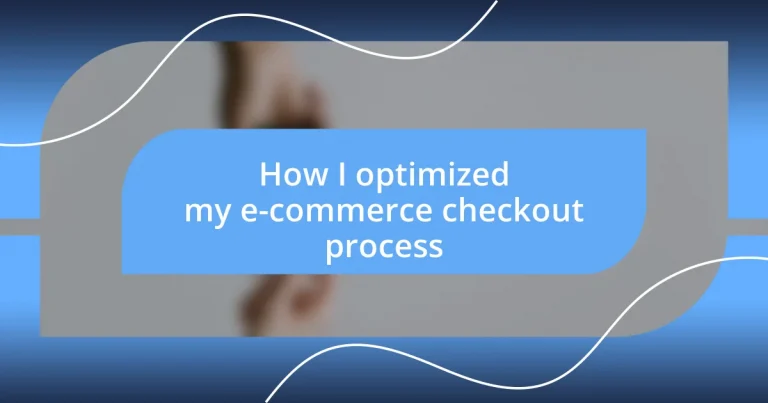Key takeaways:
- Streamlining the checkout process by reducing steps and clutter significantly improves conversion rates and customer satisfaction.
- Implementing a guest checkout option addresses customer reluctance to create accounts, leading to decreased cart abandonment and increased sales.
- Continuous analysis of data and A/B testing provide valuable insights, allowing for ongoing improvements and adaptations to the checkout experience.
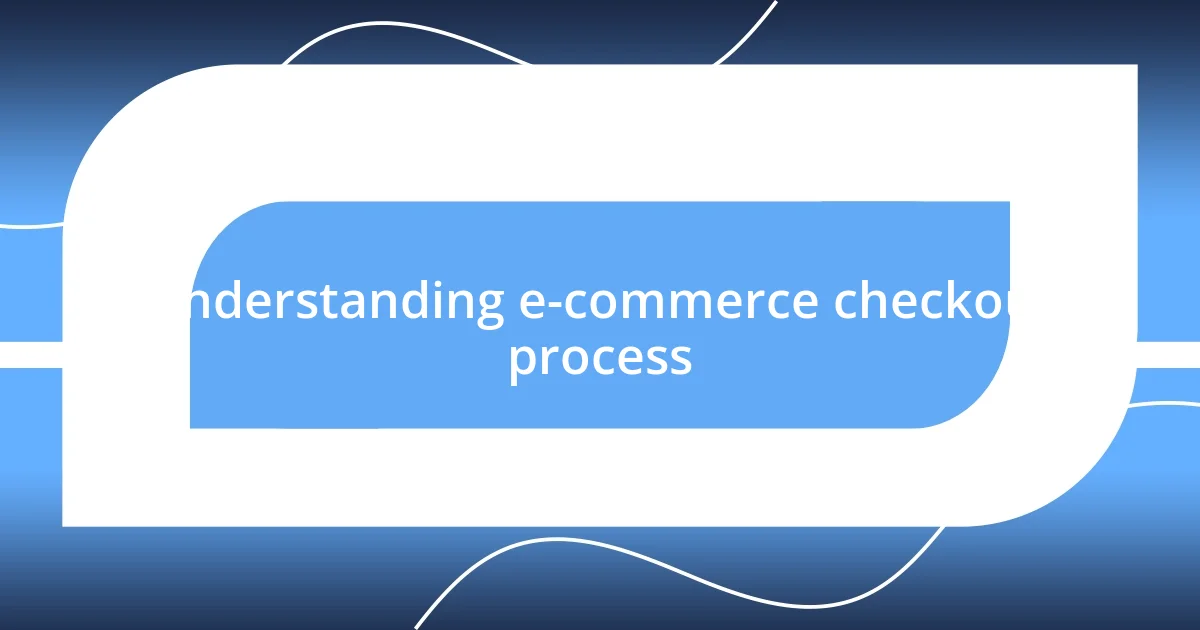
Understanding e-commerce checkout process
The e-commerce checkout process is the final step in a customer’s shopping journey, where they transition from browsing to making a purchase. I remember the first time I clicked “buy” online; the anticipation was palpable, but I also felt a twinge of anxiety about sharing my payment details. This moment highlights how critical it is to ensure your checkout process is seamless—it can either alleviate customers’ fears or amplify them.
At its core, an effective checkout process should be straightforward and intuitive. I often wonder how many potential sales are lost because visitors find the process too complicated or lengthy. Streamlining the number of steps and simplifying the required fields can make a world of difference. When I optimized my own checkout process, I found that reducing unnecessary distractions helped keep customers focused and on track.
Moreover, it’s important to consider mobile users, as more shoppers are making purchases on their phones. I experienced a significant drop in conversion rates when my site wasn’t optimized for mobile checkout. It was a revelation! By adapting the layout and minimizing steps for mobile users, I was able to enhance user experience dramatically. How have you tailored your checkout process for different devices? Each detail counts in making your customers feel secure and satisfied.
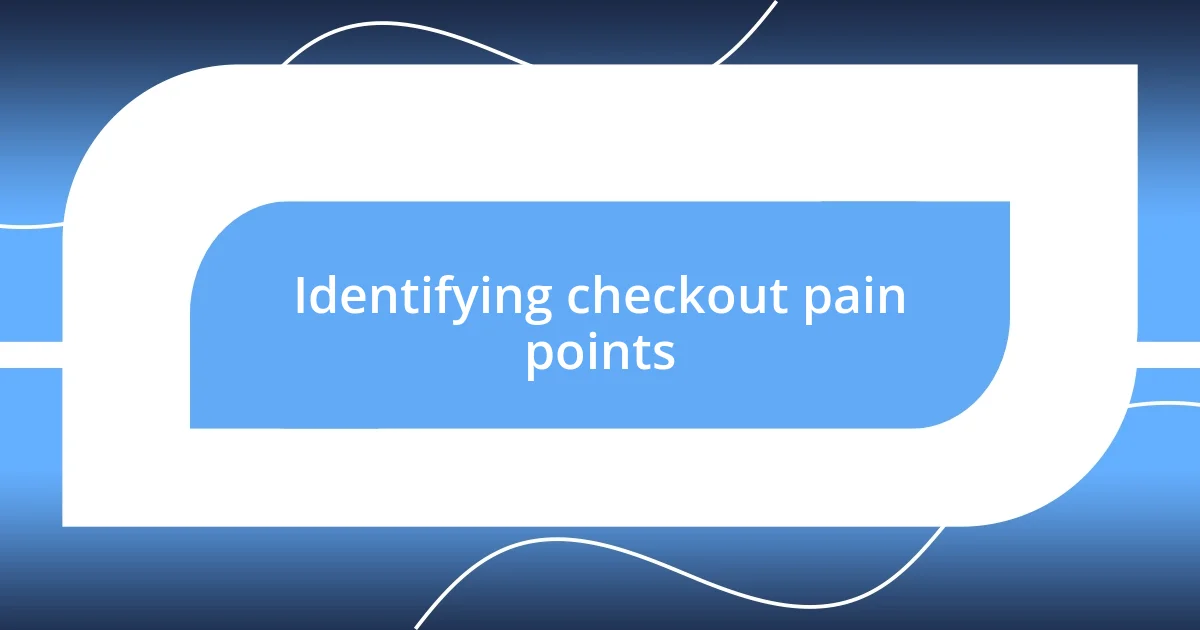
Identifying checkout pain points
Identifying checkout pain points begins with understanding your customers’ experiences. Personally, I was astonished to discover that even small hurdles—like mandatory account creation—could lead to unexpected drop-offs. This realization pushed me to evaluate my process from the customer’s perspective, ensuring I addressed their frustrations head-on.
Here are some common pain points I identified:
- Lengthy forms: Customers can be deterred by too many required fields.
- Account creation: Forcing visitors to sign up can create friction and drive them away.
- Confusing navigation: Poorly labeled buttons or progress indicators can leave customers feeling lost.
- Unclear costs: Hidden fees at the final stage often lead to cart abandonment.
- Limited payment options: It’s crucial to accommodate various preferences across your audience.
By digging into these specifics, I made targeted improvements that significantly boosted my conversion rates. I remember feeling a rush of excitement seeing those numbers climb—small changes can yield big results!
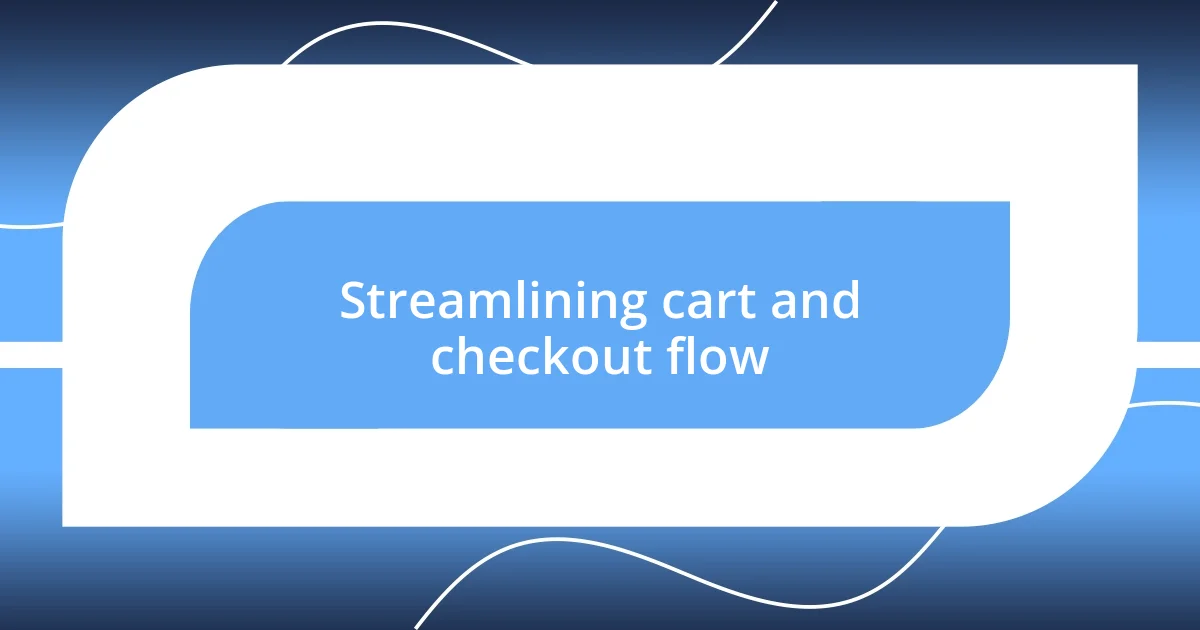
Streamlining cart and checkout flow
Streamlining the cart and checkout flow is all about making the journey as smooth as possible. When I redesigned my checkout page, I focused on reducing the number of clicks required to complete a purchase. I remember sitting at my desk, eyes glued to conversion rate graphs, and feeling a swell of satisfaction each time I saw the numbers rise after making it easier for customers to navigate. Simple changes, such as consolidating all necessary information onto a single page, resulted in a tangible boost to the overall user experience.
After implementing live chat support during the checkout process, I was pleasantly surprised by the feedback I received from customers. Often, they expressed relief at being able to get immediate assistance when they encountered a snag. This feature not only reduced cart abandonment but also created a sense of trust. In my experience, providing real-time help lets shoppers feel more at ease, especially when they’re hesitating due to concerns about security or payment methods—things we can all relate to.
To further enhance the flow, I also prioritized visual clarity, making sure the design was both appealing and user-friendly. I opted for larger buttons and clear call-to-action phrases. It’s funny how such seemingly minor tweaks can lead to major shifts in customer disposition. Customers often commented on how much less stressful the process felt. Wouldn’t you agree that the checkout experience is as important as the product itself?
| Previous Checkout Flow | Optimized Checkout Flow |
|---|---|
| Multiple pages required for checkout | Single-page checkout |
| Mandatory account creation before purchase | Guest checkout option available |
| Confusing label and navigation | Clear buttons and progress indicators |
| Complex form fields | Simplified and fewer required fields |
| Limited payment options | Diverse payment methods offered |
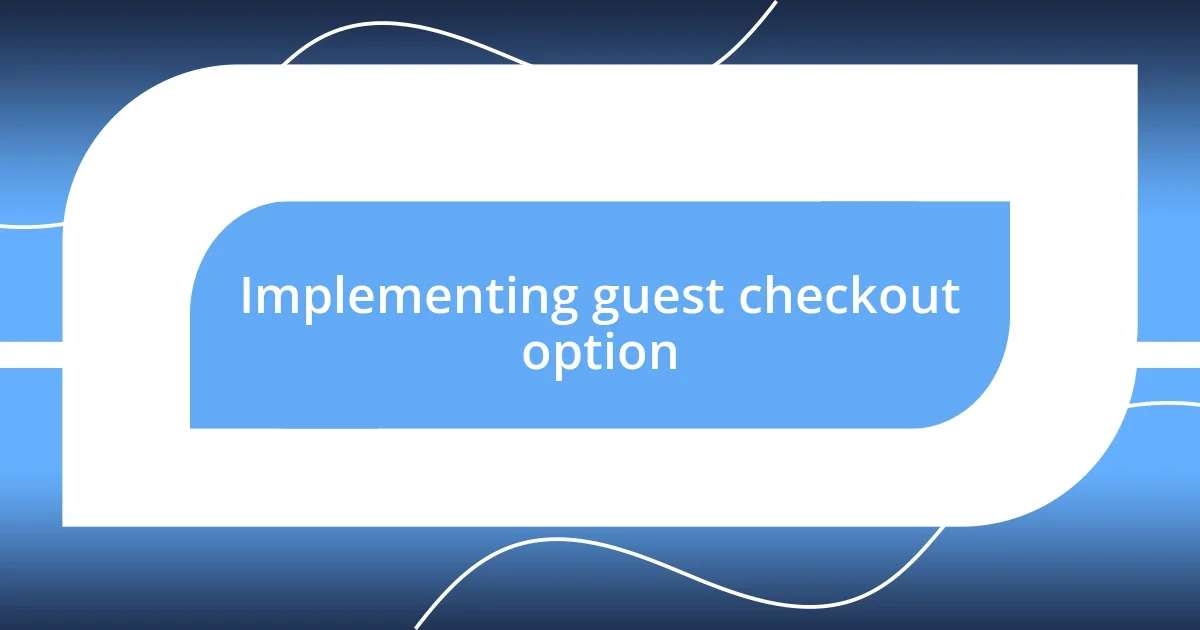
Implementing guest checkout option
Implementing a guest checkout option was a game-changer in my e-commerce experience. I remember the day I decided to make this shift—my heart raced as I thought about how many potential customers I might have lost simply because they didn’t want to create an account. It’s so easy to overlook the fact that many shoppers just want a quick and hassle-free way to purchase. By allowing them to check out without the obligation of signing up, I saw a noticeable uptick in completed transactions.
I’ve also found that many customers appreciate the flexibility of the guest checkout. It enables them to make a swift decision while their interest is piqued, rather than forcing them into a lengthy registration process that can create unnecessary hurdles. I often wondered how many abandoned carts were tied to this issue, and that curiosity motivated me to take action. And you know what? The data supported my instincts—a significant drop in cart abandonment rates became evident after the implementation.
But let’s not forget the emotional aspect. Watching customers bypass the sign-up process and successfully complete their purchases filled me with a sense of relief and joy. It was as if I had finally removed a roadblock that had been holding my business back. I couldn’t help but think—if I felt relieved, how much happier must my customers be? The guest checkout option truly turned out to be a win-win, creating a smoother and more enjoyable shopping experience that I now can’t imagine running my business without.
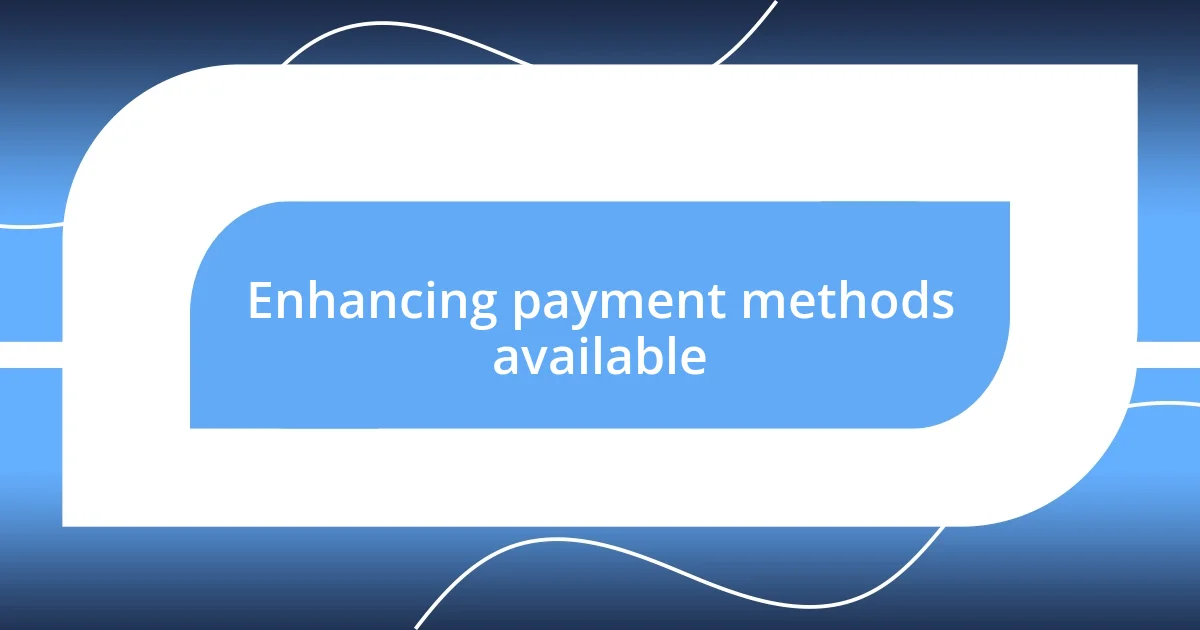
Enhancing payment methods available
Offering diverse payment methods transformed my checkout process in remarkable ways. I remember sitting down to analyze customer feedback and noticed a common theme: people love choice when it comes to payments. By incorporating options like digital wallets, PayPal, and even buy-now-pay-later services, I not only catered to varying preferences but also reassured hesitant shoppers. It’s fascinating how something as simple as adding a payment method can lift your conversion rates significantly.
One day, a loyal customer shared her excitement about being able to pay with her favorite digital wallet. She expressed that it made her shopping experience feel seamless and modern. That feedback sparked a realization for me: enhancing payment options isn’t just about convenience; it’s about making customers feel valued. As I reflect on this change, I can’t help but think—how many sales might I have missed out on by not accommodating these methods sooner?
Moreover, I’ve learned the importance of ensuring security with these alternatives. When I updated my site to highlight our encryption protocols and secure payment gateways, I noticed a shift in customer confidence. Just knowing that their financial data would be protected prompted many first-time buyers to take that leap of faith. Isn’t it amazing how a little transparency can foster trust and encourage customers to finalize their purchases?
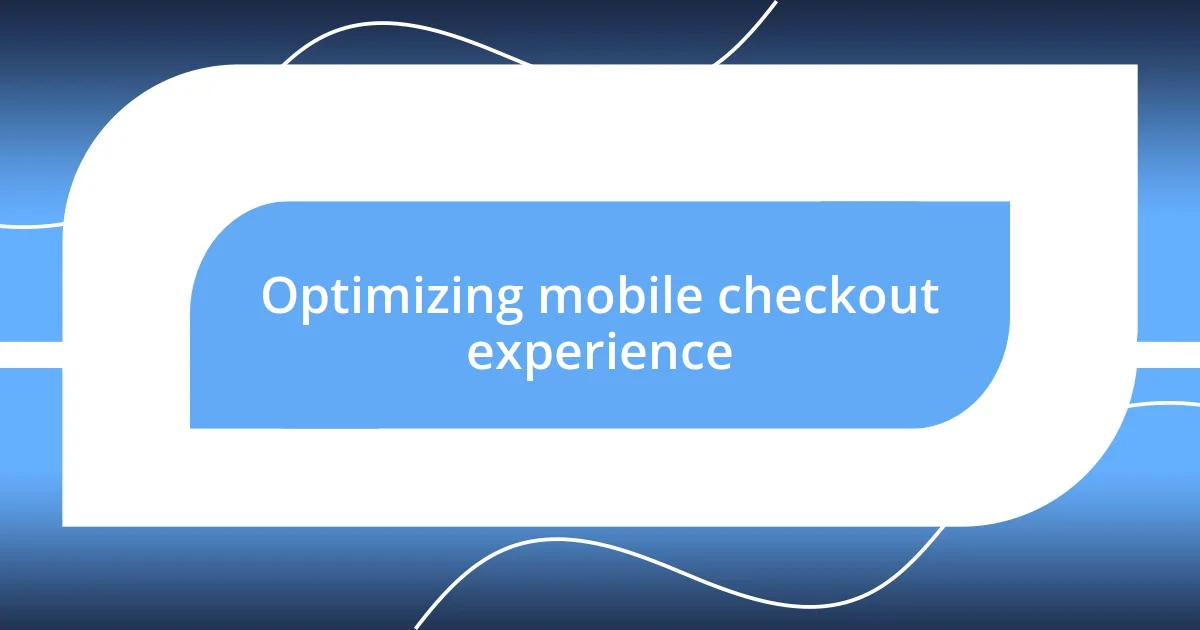
Optimizing mobile checkout experience
Optimizing the mobile checkout experience became a priority when I realized just how many of my customers were shopping on their phones. One evening, I noticed an uptick in mobile traffic but a dip in conversion rates, which sparked my curiosity. So, I took the plunge and streamlined my mobile checkout—minimizing the number of steps and ensuring that each button was easy to tap. It was a revelation! Suddenly, transactions flowed more smoothly, and I felt a rush of satisfaction watching customers breeze through.
I also paid close attention to the layout and ensured that the most critical features were easily accessible. For example, I shifted to larger buttons and input fields that were thumb-friendly. I remember one customer sharing her frustration about straining to input her payment details on other sites. This made me realize how critical comfort is in the mobile environment. That feedback drove me to prioritize design adjustments, which paid off—my bounce rates decreased, and customers seemed happier.
Moreover, I implemented a touch of personalization in the mobile experience. After seeing how responsive chat support enhanced customer satisfaction, I decided to add a small chat icon that popped up during checkout. One day, a customer reached out to ask a simple question about shipping options, and the instant assistance helped her complete her order without hesitation. It’s praiseworthy how even a small touchpoint can foster trust! Isn’t it impressive how tailoring the checkout process to mobile users’ needs can make a world of difference in driving those conversions?
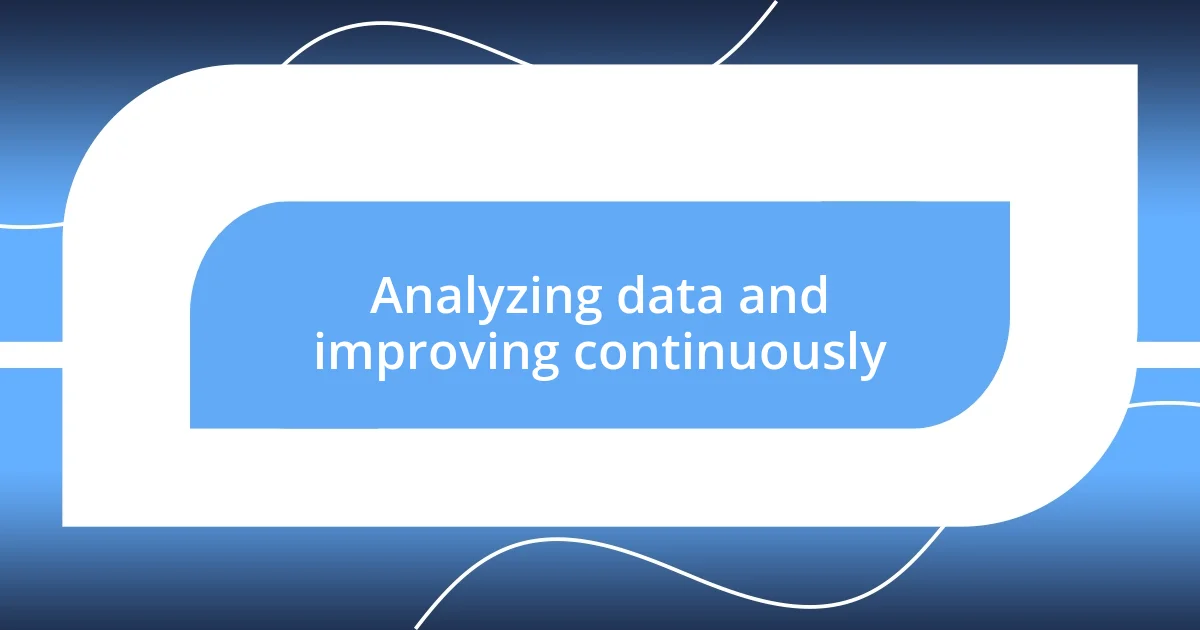
Analyzing data and improving continuously
It’s crucial to analyze data continuously to understand how my checkout process is performing. I remember diving into analytics after introducing new features—my heart raced as I reviewed drop-off rates at each step. Identifying problem areas was like uncovering hidden treasure; I could see exactly where customers were hesitating. This data-driven approach changed the way I viewed customer behavior and started a cycle of ongoing improvements.
With every tweak, I kept close tabs on conversion metrics and customer feedback. One insightful comment from a user stood out, highlighting that the checkout flow felt cluttered after a recent update. That was a lightbulb moment for me, sparking a redesign to simplify the process even more. I learned that even positive changes could lead to unexpected hurdles, and staying adaptable is key. Have you ever been surprised by feedback that led you in a completely new direction?
I truly believe improvement is never a one-and-done effort. Adopting A/B testing became my go-to strategy for optimizing my checkout process. By offering variations of the checkout page to different customer segments, I gleaned insights that guided my focus. One test revealed that a more streamlined payment section resulted in a notable increase in transactions. It’s empowering to see real-time evidence of what resonates with shoppers. Isn’t it exhilarating when data informs the path to enhanced customer experiences?












